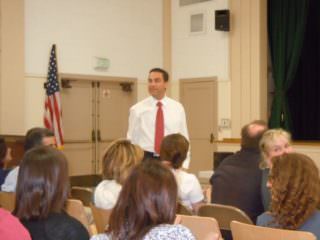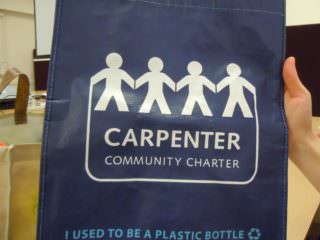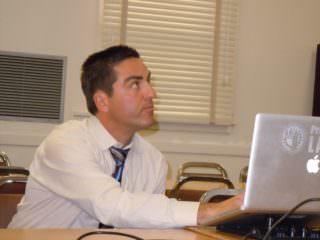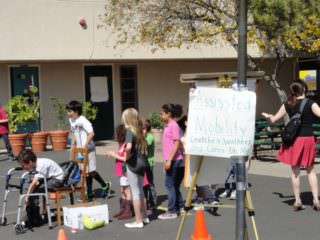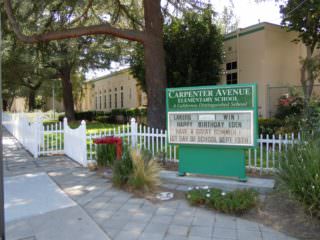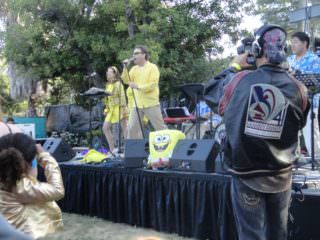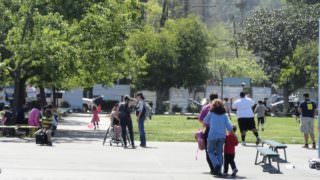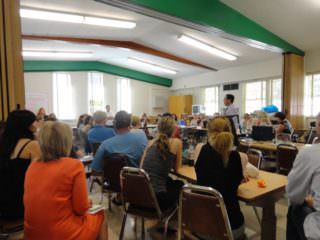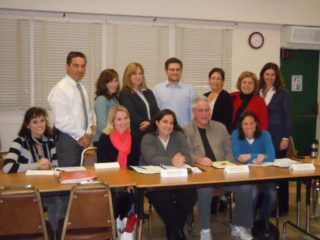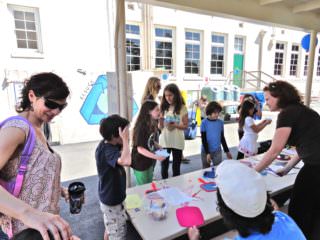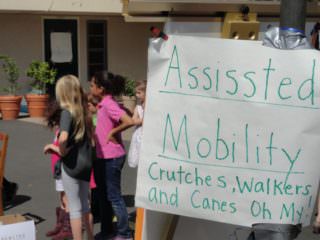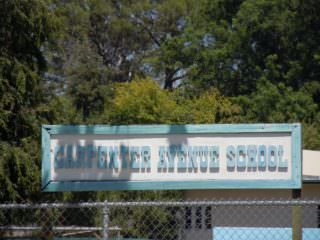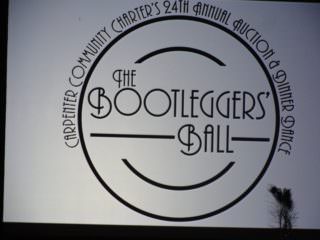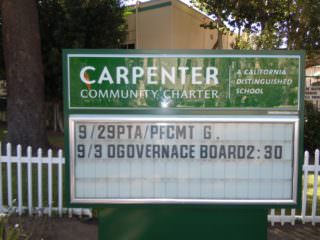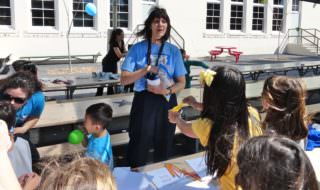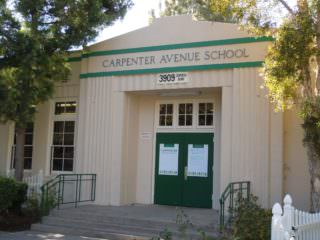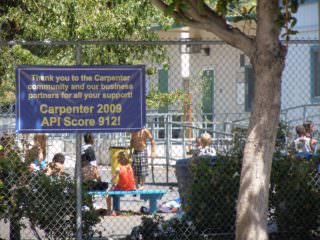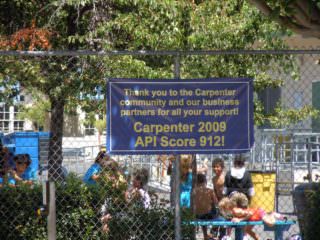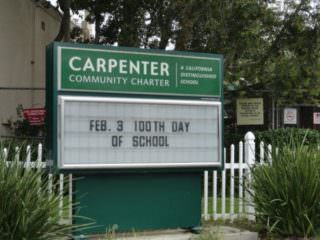The elementary school-turned-affiliated charter that became so popular parents fake their addresses
Mike Szymanski | July 11, 2016
Your donation will help us produce journalism like this. Please give today.

Joe Martinez, principal of Carpenter Community Charter School, is a sport for his school.
LA Unified has so many different kinds of schools it’s hard to keep them all straight. With such varied terms as affiliated charter, independent charter, magnet school, pilot school, continuation school, option school and others, it can be a challenge to understand what they are, what they offer and how they differ.
This is the third part of LA School Report’s examination of affiliated charter schools.
Previous stories are:
• Affiliated charters: A successful model on its way out?
• Does ‘charter’ make you look smarter? Principal of LAUSD’s newest affiliated charter says yes

Principal Martinez at a Governance Council meeting.
There isn’t much Principal Joe Martinez won’t do for his school.
He gets soaking wet while washing cars to raise money for kids who can’t afford the annual 5th grade trip to Washington, D.C. He dresses up as a sheik or a gangster for the annual fundraiser. This year he donned a tiara and a cowboy hat.
He even takes part in the unpleasant home checks to ferret out families who have faked their addresses in order to enroll in his popular Carpenter Community Charter School in Studio City, one of the wealthiest per capita ZIP codes of Los Angeles. Then, he has to gently transfer them to their proper home school.
In 2009, when some fed-up parents came to Martinez, who has worked in LA Unified since 1991, to figure out how to improve their school’s test scores, he agreed to help them become an affiliated charter school.
All three dozen teachers voted for the affiliated charter model, which allows greater autonomy in how to use school funds, as they had tired of asking parents for donations for toilet paper and photocopy paper. For parent Michellene DeBonis, the last straw was seeing her daughter’s 5th grade class swell to 41 students. “That was a killer year — never again,” said DeBonis, one of the signatories on the petition to turn the school into an affiliated charter.

Sign changes of the school in Studio City.
“It’s so important that we can choose our own way to spend that chunk of money,” DeBonis said. “We now have a mandate that we want them to work in smaller groups and figure out ways to creatively manage the numbers in the classes. That’s an affiliated charter.”
It means the school has its own autonomy as far as curriculum goes, but it relies on a lot of parent involvement and a commitment from the teachers. The school is still connected to the district as far as union contract obligations, calendar schedules and testing requirements.
When it came time to renew the school’s charter last year, a new set of activist parents explored every other kind of model for LA Unified schools. They decided once again on the affiliated charter model — even though it’s one of the least-used but most successful models available at the second-largest school district in the nation.
“When our five years ran out we started looking at pilot, magnet and independent charter models, and our strategic planning committee visited all kinds of other schools throughout the district to look at the next step for Carpenter, and they determined the affiliated model was the best one by far for us,” Martinez said. “It has served us well.”
So well, in fact, that families have faked their addresses to get in. From the moment the school sign out front changed from Carpenter Avenue Elementary School, what it had been since 1924, to Carpenter Community Charter School, it became highly sought-after. The California Distinguished School’s last Academic Performance Index score was 943 out of 1,000. It scored a 92 out of 100 in the newly released California Office of Reform Education (CORE) data.
Carpenter is the largest of all the affiliated charter elementary schools at LA Unified, at 950 students, and it is always teetering at capacity. When they had nearly 1,000 students at one point, the district had to check addresses because people who live in the area get first dibs at going there. Nearly 100 students had to be turned away, and the complex system for address verification using the LexisNexis database became a model for other schools in the district that face similar issues.
“It’s flattering, but it’s not something I prefer to spend my time on,” said Martinez, who has had to hire a Public Attendance Service counselor to go with him to conduct random home visits to see if the student’s address is actually the home. Although the charter model requires that the school have open enrollment, if the school is at capacity, like Carpenter often is, local residents get first priority, and many families said they bought million-dollar homes nearby or found apartments in the area in order to get into the school. Now Martinez checks out new applications before the beginning of the school year and finds about 75 to 100 have falsified their home address.
Carpenter is among the first wave of affiliated charter schools that applied in the San Fernando Valley. Today, of the 54 that now exist (including the latest, Sylmar Charter High School), 44 affiliated charters are in the San Fernando Valley and most of those are in higher-income neighborhoods such as Sherman Oaks and Woodland Hills.
FAMOUS FACES
Carpenter’s neighborhood — near one of LA’s oldest movie studios and peppered with familiar film location sites like the houses used in the Kardashian reality show, “The Brady Bunch” and “Malcolm in the Middle” — means many celebrities who send their kids to Carpenter end up getting involved with the school.

Carpenter parents Denise DaVinci, a New York City fashion designer, and Tom Kenny, the voice of SpongeBob SquarePants.
“I can’t speak for other schools, but Carpenter always had a reputation for a lot of parent involvement,” Martinez said. “We also have a lot of children working in the industry, and the biggest drawback to that is that our absentee numbers go up because they are off making movies.” (Carpenter at one point had more than a 10 percent chronic absent rate.)
Martinez vigilantly protects the privacy of the famous families that attend the school, but they include recognizable city officials and Grammy and Emmy award winners. One mom, Denise DaVinci, a New York City fashion designer, helped Carpenter come up with a new logo and a line of clothing, and for a few years she harnessed the famous talent among the parents for end-of-the-year school shows.
“We could never publicize the high level of quality talent we had performing at our school events because too many people would come from all around to see the shows,” DaVinci said. “Suffice it to say that if you drove by and heard some familiar song during one of our school events, it wasn’t a recording and it wasn’t a cover band, it was the real thing.”
For years Tom Kenny, the voice of SpongeBob SquarePants, performed and hosted events at the school when his children attended, and he frequently brought along the SpongeBob Band, much to the delight of the students. Carpenter holds a regular golf tournament fundraiser and throws parties at the nearby CBS Studios. This year, their Denim and Diamonds Ball on the studio backlot attracted 650 guests and offered two-stepping and mechanical bull-riding.
RAISING MONEY
Families are asked by the fundraising arm of the school to donate at least $800 per child, but it is not required, nor can it be required. No school in LA Unified is allowed to require any amount of donation nor any amount of volunteer hours, charter or not. But that doesn’t mean the school doesn’t raise more money than traditional schools.
At Carpenter, the average gift was $948 per family last year, far exceeding the ask. More than 20 families gave more than $3,000. Carpenter has very different demographics from the rest of the district; it has a 4 percent socio-economically disadvantaged population while the rest of the district is at 77 percent.
“I think parents at non-Title 1 high-performing schools definitely need to contribute if the school community wants an enriched educational experience for their kids,” Martinez said. “So yes, I think it goes without saying.”
Carpenter not only has its standard PTA, but also a nonprofit Parents for Carpenter that has raised more than $600,000 in the last year. All of it goes back to the school.
“The reason why the community wants their kids to come to our school is that we can offer those enrichment activities you don’t find at your typical school,” Martinez said. “Having a PE coach, or a full-time music teacher, or a full-time dance teacher and a full-time science teacher is practically unheard of in any other elementary school campus,” Martinez said. “So if a school community identifies those areas that they really want to highlight or shine, and guarantee that all kids have access to it, they have to do fundraising for that, absolutely.”

Carpenter’s Governance Council
Such decisions are made by a Governance Council made up of an equal number of parents and community members (eight) and staff, teachers and the principal (eight). Sometimes the meetings get contentious when the parents seem to have priorities that are different from the teachers, but they always get ironed out. And the affiliated model’s autonomy allows them to be a bit more creative when it comes to what is being taught, and how.
For example, this past school year, LA Unified said Carpenter could hire another teacher, but instead the Governance Council decided to take the $41,000 from the district and use it for other programs. They made it work out so it didn’t translate into larger class sizes because the teachers agreed to do split classrooms and share students.
TEACHER SUPPORT
“As a teacher, in an affiliated charter school you are not shackled by what the district gives you,” said Nick Glover, a teacher who serves on the Governance Council and introduced some of the innovative programs offered at Carpenter. Glover was among the teachers at the school six years ago who all unanimously agreed to try the affiliated charter model. He doesn’t regret it.
“From a teacher’s perspective we still have union coverage and benefits — everything is still the same — the basic thing we are gaining is to explore other avenues with less constraints than we would have with the district,” Glover said. The school can decide what to use block grants for, and Glover promoted programs like the unique Singapore Math style of teaching that is being rolled out in the school at different grade levels. They don’t use the district’s textbooks, and there was training for teachers in Las Vegas, and so the school had to figure out how to pay for it.
“We could pilot something new, and if it doesn’t work, we can work out the kinks,” Glover said.
“We know our clientele, our families here, don’t want a run-of-the-mill curriculum, so we can supplant and supplement wherever possible,” Glover said.
Another teacher, Christine Shahine, brought the relaxation technique of MindUP started by Goldie Hawn; the actress herself trained Carpenter’s teachers in the technique. It’s a research-based training program for educators that teaches children how to relax and concentrate, and aligns with Common Core.
“This is one of the new programs we brought in while reapplying as an affiliated charter, and it introduces meditation during the school day where kids focus on their emotions and their words,” Martinez explained. “It’s almost like your mother said, ‘Think before you speak.’ There’s a series of exercises we do every day with the kids when they come in from recess or lunch and everyone is hot and sweaty and arguing about what happened on the handball court. The teacher can ring a bell, have the kids close their eyes and go through a mental exercise of just focusing on their own breathing and letting go of the stress they have just brought into the classroom from the outside world.”
Carpenter is one of 20 pilot schools in the district trying the MindUP technique, and Martinez hopes to see test scores improve this year because of it.
The school also started the Write from the Beginning writing program and Engineering is Elementary, a program out of Boston.
“Our population is unique, we do not have a high English learner population, so we do not have the same needs as most of the schools in the district,” Glover points out.
Carpenter has a 4 percent English learner population while the average school in the district has 22 percent. Carpenter is 76 percent white and 8 percent Latino. LA Unified is about 10 percent white and 74 percent Latino.
“This affiliated model has allowed us to unify all the groups on campus and have a greater transparency,” Martinez said. He knows he cannot ask the teachers to work more, but many have seen what goes on in the Governance Council and want to be a part of it.
“You have to be very involved, everyone does,” Martinez said. “There’s no question about it, it’s tough. But ultimately, it’s worth it.”
And for that reason, he’ll put on a tiara or a cowboy hat and ride a mechanical bull to help his affiliated charter school thrive.
